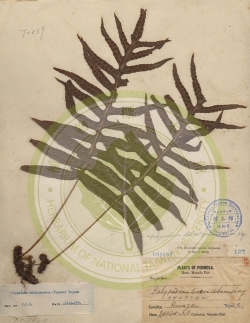|
Tags: plant | type specimen
 The original specimen from which the description of a new species is made is known as type specimen, which should be preserved forever. When a new species is identified, after checking the collected specimen with referential literature, a detailed description of the morphological characteristics of the species usually needs to be published, accompanying by illustrations and indicating Herbarium where the specimens is stored. The large-scale exploration of plant resources of Taiwan started from Japanese colonial period so that more than 1,300 new species were discovered. Most type specimens were sent to Tokyo Imperial University or to the herbarium in the Central Forest Department of Taiwan Governor General Office. The epic center of Taiwan plant resource exploration shifted to the Department of Plant Taxonomy and Ecology in Taihoku Imperial University, after it was founded in 1928. The exploration of plant resources in Japanese colonial period also expanded to Java, Sumatra, Borneo, Hainan Island, and Micronesia islands the South Pacific. Including the specimens from those areas and specimens collected in mainland China after 1946, there are more than 1,000 specimens of type species in total, of which 673 were collected in Taiwan, 206 in Micronesia Islands, 54 in mainland China (such as Sichuan, Guangdong, Guangxi, Zhejiang, and Hainan), 7 in Japan, 30 in Okinawa, and the rest were collected in Vietnam, Africa and other places. The preservation and digitalization of these valuable biological specimens of type species will provide reference and index for species identification and benefit the researchers in plant taxonomy.
The original specimen from which the description of a new species is made is known as type specimen, which should be preserved forever. When a new species is identified, after checking the collected specimen with referential literature, a detailed description of the morphological characteristics of the species usually needs to be published, accompanying by illustrations and indicating Herbarium where the specimens is stored. The large-scale exploration of plant resources of Taiwan started from Japanese colonial period so that more than 1,300 new species were discovered. Most type specimens were sent to Tokyo Imperial University or to the herbarium in the Central Forest Department of Taiwan Governor General Office. The epic center of Taiwan plant resource exploration shifted to the Department of Plant Taxonomy and Ecology in Taihoku Imperial University, after it was founded in 1928. The exploration of plant resources in Japanese colonial period also expanded to Java, Sumatra, Borneo, Hainan Island, and Micronesia islands the South Pacific. Including the specimens from those areas and specimens collected in mainland China after 1946, there are more than 1,000 specimens of type species in total, of which 673 were collected in Taiwan, 206 in Micronesia Islands, 54 in mainland China (such as Sichuan, Guangdong, Guangxi, Zhejiang, and Hainan), 7 in Japan, 30 in Okinawa, and the rest were collected in Vietnam, Africa and other places. The preservation and digitalization of these valuable biological specimens of type species will provide reference and index for species identification and benefit the researchers in plant taxonomy.
National Taiwan University Herbarium Digital Archives Project
National Taiwan University
|